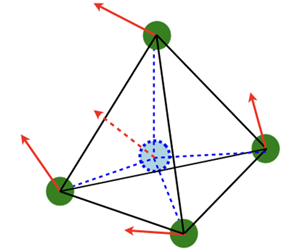Article contents
Dynamics and invariants of the perceived velocity gradient tensor in homogeneous and isotropic turbulence
Published online by Cambridge University Press: 09 June 2020
Abstract

The perceived velocity gradient tensor (PVGT), constructed from four fluid tracers forming a tetrahedron, provides a natural way to study the structure of velocity fluctuations and its dependence on spatial scales. It generalizes and shares qualitatively many properties with the true velocity gradient tensor. Here, we establish the evolution equation for the PVGT, and, for homogeneous and isotropic incompressible turbulent flows, we analyse the dynamics of the PVGT in particular using its second- and third-order invariants. We show that, for PVGT based on regular tetrads with lateral size  $R_{0}$, the second-order invariants can be expressed solely in terms of the usual second-order velocity structure functions, while the third-order invariants involve the usual third-order longitudinal velocity structure function and a less well known three-point velocity correlation function. For homogeneous and isotropic turbulence, exact relations between the second moments of strain and vorticity, as well as enstrophy production and the third moments of the strain, are derived. These generalized relations are valid for all ranges of
$R_{0}$, the second-order invariants can be expressed solely in terms of the usual second-order velocity structure functions, while the third-order invariants involve the usual third-order longitudinal velocity structure function and a less well known three-point velocity correlation function. For homogeneous and isotropic turbulence, exact relations between the second moments of strain and vorticity, as well as enstrophy production and the third moments of the strain, are derived. These generalized relations are valid for all ranges of  $R_{0}$, and reduce to classical results for the velocity gradient tensor when
$R_{0}$, and reduce to classical results for the velocity gradient tensor when  $R_{0}$ is in the dissipative range. With the help of these relations, we quantify the importance of the various terms, such as vortex stretching, as a function of the scale
$R_{0}$ is in the dissipative range. With the help of these relations, we quantify the importance of the various terms, such as vortex stretching, as a function of the scale  $R_{0}$. Our analysis, which is supported by the results of direct numerical simulations of turbulent flows in the Reynolds-number range
$R_{0}$. Our analysis, which is supported by the results of direct numerical simulations of turbulent flows in the Reynolds-number range  $100\leqslant R_{\unicode[STIX]{x1D706}}\leqslant 610$, allows us to demonstrate that strain prevails over vorticity when
$100\leqslant R_{\unicode[STIX]{x1D706}}\leqslant 610$, allows us to demonstrate that strain prevails over vorticity when  $R_{0}$ is in the inertial range.
$R_{0}$ is in the inertial range.
JFM classification
Information
- Type
- JFM Papers
- Information
- Copyright
- © The Author(s), 2020. Published by Cambridge University Press
References
- 7
- Cited by

